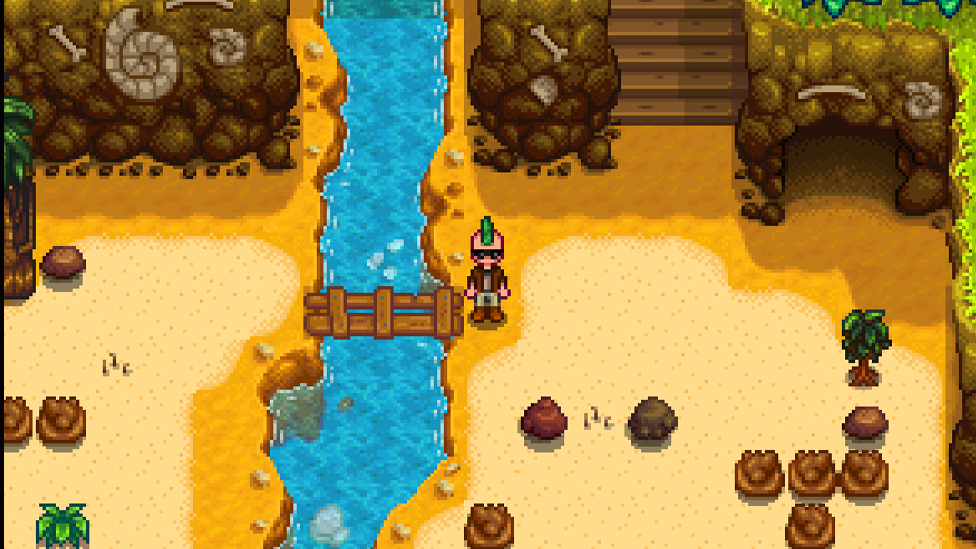Stardew Valley Ginger Island Fossils
What are Stardew Valley’s Ginger Island Fossils?

Make Your Own Stardew Valley Server
Before we go any further, we first need to consider the different types of fossils that are available on Ginger Island. In short: every type of fossil in the game can be found on Ginger Island, making it a must-see destination for anyone looking for more fossils and bone fragments
There are several common types of fossils that can be found on Ginger Island, such as nautilus, amphibian, and palm fossils, as well as common skeletal parts like skeletal tails and prehistoric vertebra. These can also be found in many other locations throughout the game; however, some fossils in Stardew Valley are exclusively limited to Ginger Island, like fossilized leg bones.
Where to Find Fossils in Stardew Valley
There are numerous places that you can find fossils in Stardew Valley, and keeping these in mind could help you pick the right gathering method for your needs. Just a few of the different ways that you can find fossils in Stardew Valley include the following:- Ginger Island Dig Site: One of the main sources of bones in Stardew Valley is the Ginger Island Dig Site, where numerous bone nodes can be found that drop a variety of fossils and bones. In addition to bone nodes, there are also numerous clay nodes, rocks, and even mahogany tree seeds that provide opportunities for further foraging and harvesting.
- Artifact Spots: Another common source of fossils in Stardew Valley is from artifact spots. This will likely also be how you get your first fossils in the game, since the dig site is locked until you have gotten to Ginger Island.
- Monster Drops: Did you know that some bones can be dropped by monsters, such as Haunted Skulls having a 1.3% chance to drop a prehistoric skull or skeletal hand or a Pepper Rex having a 30% chance to drop a prehistoric tibia, prehistoric vertebra, or prehistoric rib.
Given that there are several ways to obtain fossils in Stardew Valley, the dig site in Ginger Island is unlikely to be the first place you get hold of fossils. However, it is worth keeping in mind that having access to the Ginger Island Dig Site will significantly increase your ability to access valuable bones and fossils.

However, it doesn’t matter whether you’re planning for the early game or late game; having a stable Stardew Valley server is
critical. Fortunately, Scala Cube’s premium servers help ensure that your game remains stable and reliable with 24/7 uptime, going forward.
How Prevalent are Fossils in The Ginger Island Dig Site
Fossils are incredibly common from bone nodes at the Ginger Dig Site, alongside a variety of other types of nodes. Of these, the most common type of bone that you will obtain from bone nodes is bone fragments, however, you can also get a range of additional bones, such as:- Fossilized legs
- Fossilized Ribs
- Prehistoric Scaptula
- Prehistoric Skull
- Prehistoric Tibia
- Prehistoric Rib
- Prehistoric Vertebra
- Skeletal Tail
- Skeletal Hand
- Palm Fossil
- Trilobite
- Nautilus Fossil
- Amphibian Fossil
Are Fossils Worth Gathering in Stardew Valley?

Fossils are definitely worth gathering in Stardew Valley for several reasons. For one thing, bone fragments and bones are incredibly valuable for crafting fertilizers and speed gro; in addition, fossils and prehistoric bones can be donated to the museum, counting towards your total count. Some types of fossils can alternatively be donated to the Island Field Office, counting towards the Large Animal collection; this allows you to work towards completing this collection.
Frequently Asked Questions
What are the different ways to obtain bones in Stardew Valley?
There are several ways to obtain bones and fossils in Stardew Valley. These include visiting the dig site in Ginger Island, digging in artifact spots, and from monster drops.
How many types of fossils and bones are there in Stardew Valley?
There are many different types of fossils and bones in Stardew Valley. In addition to bone fragments, there are six types of fossils (trilobites, palms, amphibians, nautilus, legs, and ribs), prehistoric bones (scapula, tibia, skull, ribs, and vertebra), and skeletal bones (hands and tails).
What do Ginger Island bone nodes look like in Stardew Valley?
Bone nodes at the dig site on Ginger Island are either gray or brown rocks with bones sticking out of them. Gray bone nodes ave five bone fragments sticking out of them, while brown bone nodes have four plus an additional swirled bone mark on the stone.
Final Thoughts
There are many different materials in Stardew Valley that you could potentially use, although many of these are hard to come across. One such example is fossils, which are hard to find - at least in the early game. However, once you unlock Ginger Island and its dig site, getting hold of fossils in Stardew Valley becomes a lot easier. This can help make your fossil collecting efforts much simpler and more predictable, also allowing you to harvest bone fragments more readily too.
Make Your Own Stardew Valley Server
Copyright 2019-2026 © ScalaCube - All Rights Reserved.